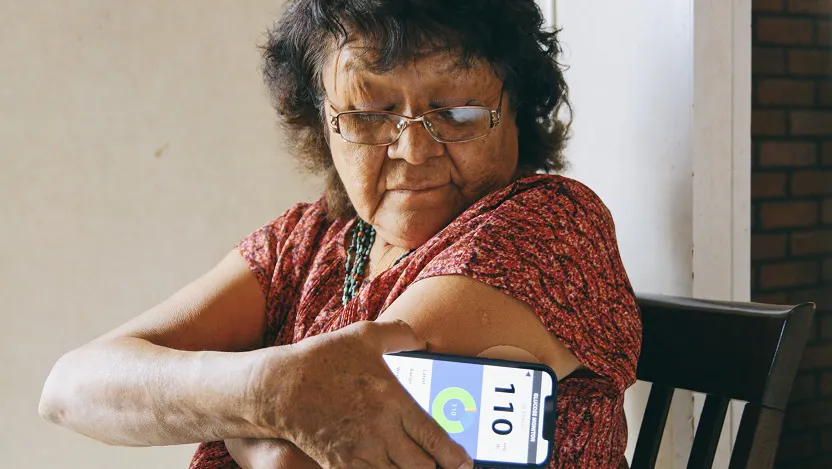Diabetes in older adults: Risks, treatments and health habits to know

Diabetes affects nearly 38.4 million people in the United States, or 11.6% of the population.
And the prevalence grows with age: Nearly 1 in 3 people ages 65 and older has diabetes, according to the Centers for Disease Control and Prevention.
Diabetes is characterized by consistently high glucose (sugar) levels in the blood. Diabetes doesn’t have a cure, but it can be managed with exercise, healthy eating, weight loss, monitoring and medication, said Ahmid Dredar, MD, a primary care physician with UChicago Medicine Medical Group*.
“Under appropriate medical care, it can be something that doesn’t have to drastically alter your life or overwhelm you,” said Dredar, who practices at UChicago Medicine Kenwood.
The primary care doctors at UChicago Medicine Kenwood, including Dredar, focus on meeting the unique needs of patients 55 and older. They may involve a social worker, perform fall risk assessments and review the regimens of patients taking five or more medications to help with medication management.
Dredar explained diabetes signs and symptoms, easy lifestyle modifications and unique challenges the disease poses for older adults.
What is diabetes?
When we eat, most of our food is broken down into glucose, which the body uses for growth and energy. Insulin, a hormone, moves glucose from the bloodstream into individual cells, giving each cell the energy it needs to function.
Diabetes is a condition that occurs when a person’s blood glucose is too high, due to the pancreas either not making enough insulin — or not making any at all.
What are the types of diabetes?
There are different types of diabetes, including Type 1, Type 2, and gestational (diabetes while pregnant.) The vast majority of those with diabetes (90 to 95%) have Type 2.
- In Type 1 diabetes, the pancreas doesn’t make insulin. It can develop at any age, and medication (insulin) is necessary to manage it. Two million Americans have Type 1 diabetes, including 304,000 children and teens.
- In Type 2 diabetes, your body becomes resistant to insulin. It’s usually diagnosed in adults ages 45 and older, although it’s being diagnosed more often in younger people. Contributing factors include obesity, lack of physical activity, diet, hormonal imbalance, family history and certain medications.
What challenges do older people face when managing diabetes?
Diabetic complications can be more severe in older people, Dredar said. This can lead to an increased risk of cardiovascular disease, kidney disease, neuropathy and visual impairment.
“It’s important to have an annual eye check and annual diabetic foot exam to ensure that diabetes hasn’t progressed to affect other organs and tissue,” Dredar said.
What are the warning signs of diabetes, especially in older people?
- Fatigue
- Increasing thirst or hunger
- Unintentional weight loss
- Urinating often
- Blurry vision
- Skin infections or slow healing from cuts and bruises
Some people may not realize they have developed diabetes because symptoms often start slowly and go unnoticed.
“Older adults sometimes dismiss these symptoms as simply a part of getting older, but they can be signs of a serious issue,” Dredar said. “Follow up with your primary care physician to discuss any changes you have noticed.”
What lifestyle habits support diabetes management in older adults?
Many people with Type 2 diabetes can manage blood glucose levels with diet and exercise. Exercises that are low impact and easy to do include:
- Walking
- Swimming
- Cycling
- Dancing
- Yoga
- Resistance band training
Eat foods rich in vitamins, minerals, antioxidants and fiber:
- Whole grains
- Dark leafy vegetables
- Nuts
- Beans and lentils
- Fish high in Omega-3 fatty acids, such as salmon
- Broccoli
- Berries and citrus fruits
How often should older individuals see their care providers for diabetes care?
People who have diabetes typically follow up with their doctor every 3 to 6 months. They may require closer follow-up if their sugar levels are uncontrolled or they are developing side effects.
Some patients may need pills or insulin injections. Your physician and a diabetes educator can help you understand diabetes and provide support. In certain cases, you may be referred to a diabetes specialist known as an endocrinologist.
“Every patient has an individualized treatment plan,” said Dredar, who can provide a referral to a geriatrician — a doctor with specific training in the unique health needs of older adults — for those who need it. “Make sure you discuss your care and symptoms with your doctor.”
The UChicago Medicine Kovler Diabetes Center offers a patient-centered, science-based approach for managing insulin-dependent Type 1 and complex Type 2 diabetes.
How can older adults with diabetes measure and track their health?
Some people with diabetes require daily monitoring of blood glucose levels. If you are managing your diabetes without taking insulin, you may not be required to check your glucose as often.
Ask your doctor what your target blood sugar levels should be. Regular monitoring can help keep blood sugar in control and prevent serious damage to your eyes, kidneys and nerves.
*Dr. Dredar is a UChicago Medicine Medical Group physician. UChicago Medicine Medical Group is comprised of UCM Care Network Medical Group, Inc. and Primary Healthcare Associates, S.C. UChicago Medicine Medical Group providers are not employees or agents of The University of Chicago Medical Center, The University of Chicago, UChicago Medicine Ingalls Memorial, or UChicago Medicine Kenwood.
Kovler Diabetes Center
UChicago Medicine offers a patient-centered, science-based approach for managing insulin-dependent Type 1 diabetes, complex Type 2 diabetes, gestational, pre-diabetes and monogenic diabetes.
Learn more about our expertise